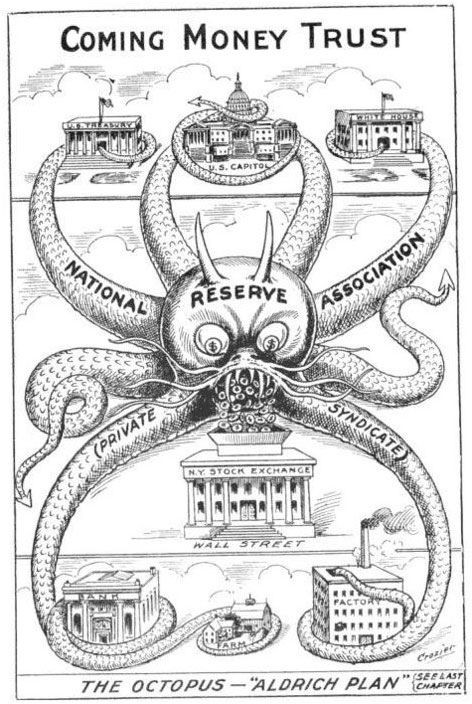2014 The Year The Federal Reserve Goes Bankrupt
Post on: 28 Июль, 2015 No Comment

Stay Connected
Sometimes when I am studying the Federal Reserve financial statements, I doubt my own sanity. I pace the floor saying aloud, No, this can’t be right. And other than my dog, no one seems to offer a response. It’s just Ed mumbling again, he may be losing it… And yet, I will keep explaining my understanding of the accounting abuse on the Fed balance sheet because I believe it is a matter of public interest, or at least it should be. And, if I’m looking at it wrong, I’m asking for comments to set me straight. I would be relieved to find out that I’m wrong on this one.
I will begin with my standard disclaimer that I am not a ranting conspiracy theorist, and I am only using publicly available information. Currently, I am studying the Federal Reserve Banks Combined Quarterly Report of September 30, 2013 — Unaudited . Fortunately, the Fed is pretty good at providing disclosures to its financial statements. Literally, they are not hiding the information that I will present. And yet, through an accounting sleight of hand, our central bank’s refusal to follow mark-to-market accounting creates an image of prosperity, when in fact, the bank is having a terrible year. And it could get worse, because rates have nowhere to go but up, and our fixed-income managers at the Fed have, ostensibly, taken on some long-dated fixed-income exposure. I say ‘ostensibly’ because I am not privy to any hedging that may be going on inside of the Fed’s portfolio. It may be buried in the notes somewhere…I keep re-reading them.
How About Losing 31 London Whales?
Jamie Dimon was hung out and demonized when his firm lost $6 billion. So far this year, the Fed lost $189 billion on its bond portfolio. That’s an entire pod of London whales! And yet, the income statement of our Federal Reserve for the nine months ended shows an income of $56 billion, and fully $55 billion of that was dutifully sent over to the Treasury. Ah, the miracles of accrual accounting! You see, I have explained in a couple articles in the past that the Fed does not use market-standard accounting practices. It has literally created its own rule that it does not measure changes in the market value of its bond holdings as income or loss. The bonds are amortized and carried at cost, with interest received counted as income. And, it’s a good thing! Because these past nine months have been torture on the Fed’s balance sheet.
Source: Table 10, page 12 – in billions, rounded by author
Portfolio Management
In the face of these stunning losses, one may wonder, what comes next? While the answer is not that easy to forecast, following is a very rough idea of the potential impact on the balance sheet since September 30. First, I will set out the assumptions:
- 25% of the Treasury Portfolio (TP) is >10 years tenor, with a duration of 8.6.
- 40% of the TP is 5-10 year, with a duration of 4.8.
- Let’s ignore the rest of the TP.
- 99% of the MBS Portfolio is >10 years, but the weighted average life is 5.9 years.

- Let’s assume the MBS portfolio behaves similarly to the Bloomberg US Agency bond index.
According to a very rudimentary model, the Fed’s portfolio would have lost an additional $5 billion since September 30, with gains in MBS offsetting losses in Treasuries.
Notes:
- The assumption about the relationship of the MBS portfolio to the Bloomberg Index is my conjecture. It may be sloppy math. I wasn’t able to backtest it, because the Fed portfolio is dynamic and increased by over $650 billion in the nine-month period.
- Durations were taken from the Ryan Indices in the Wall Street Journal .
- Yield changes were taken from the Treasury website.
- Computation errors, if any, reside with me. I will provide updated analysis when the year-end report comes out, and will also check these assumptions.
Rough Guess at a Fed MTM Balance Sheet
The following table contains an approximation of what the Federal Reserve balance sheet would look like if it were presented on an MTM basis instead of accrual accounting. I have used highly condensed statements for illustrative ease, and the rounding and grouping of assets was done by me; it is not an official statement from the Fed. Also, I have assumed that the PV of liabilities has not changed since they are so short-dated and credit risk prices for Fed debt do not exist.
The net result is that the Fed is still sitting on some unrecognized gains on its bond portfolio (about $25 billion), and if we include the long-term gain on its gold holdings (the Fed reports their gold at $42 per ounce, not $1,325, which is where gold traded in late September), there is still some cushion in the capital of about $360 billion.
So, the Fed hasn’t gone bust — yet. And since they do not follow the industry standard accounting practices, they will continue to show market value losses only in the footnotes. However, if we have a continued rise in interest rates (and a continued deterioration in the price of gold), one can expect further deterioration in the fair value of the balance sheet to the point where the Fed might show a negative capital position on a fair value basis. And in layman’s terms, we call that a busted bank.
Of course, the Fed could always print more money to cover the deficit…
Editors note: Edward Hoofnagle. CFA, founded and sold a variety of companies in the technology and consulting industry, and currently manages an investment portfolio of private companies. Ed also provides business advisory services and offers interactive seminars for entrepreneurs and family offices related to financial literacy and charitable planning.














